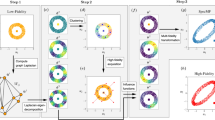Abstract
We introduce the following class of mesh recovery problems: Given a stiffness matrix A and a PDE, construct a mesh M such that the finite-element formulation of the PDE over M is A. We show, under certain assumptions, that it is possible to reconstruct the original mesh for the special case of the Laplace operator discretized on an unstructured mesh of triangular elements with linear basis functions. The reconstruction is achieved through a series of techniques from graph theory and numerical analysis, some of which are new and can find application in other scientific areas. Finally, we discuss extensions to other operators and some open questions related to this class of problems.
Similar content being viewed by others
References
T.F. Chan and J. Zou, Additive Schwarz domain decomposition methods for elliptic problems on unstructured meshes, CAM Report 95–16, Department of Mathematics, UCLA (March 1995).
R.S. Dembo, S.C. Eisenstat, and T. Steihaug, Inexact Newton methods, SIAM J. Numer. Anal. 19 (1982) 400–408.
J.E. Dennis, Jr. and R.B. Schnabel, Numerical Methods for Unconstrained Optimization and Nonlinear Methods, Classics in Applied Mathematics (SIAM, Philadelphia, PA, 1996).
S. Even, Graph Algorithms (Computer Science Press, 1979).
E. Hinton and D.R.J. Owen, Finite Element Computations (Pineridge Press, 1979).
J. Liesen, E. de Sturler, A. Sheffer, Y. Aydin and C. Siefert, Efficient computation of planar triangulations, in: Proc. of the 10th Internat. Meshing Round Table, 2001, accepted.
G.L. Miller, S.-H. Teng, W. Thurston and S.A. Vavasis, Automatic mesh partitioning, in: Sparse Matrix Computations: Graph Theory Issues and Algorithms, eds. A. George, J. Gilbert and J. Liu, IMA Volumes in Mathematics and its Applications (Springer, New York, 1993).
J. Ruge and K. Stüben, Algebraic Multigrid (AMG), in: Multigrid Methods, ed. S. McCormick, Frontiers in Applied Mathematics, Vol. 5 (SIAM, Philadelphia, PA, 1987).
Y. Saad, SPARSKIT: A basic toolkit for sparse matrix computations, RIACS, NASA Ames Research Center, TR90–20, Moffet Field, CA (1990).
Y. Saad, Iterative Methods for Sparse Linear Systems (PWS Publishing, 1996).
A. Sheffer and E. de Sturler, Parameterization of faceted surfaces for meshing using angle based flattening, Engineering with Computers (2002) to appear.
D. Spielman and S.-H. Teng, Spectral partitioning works; planar graphs and finite element meshes, FOCS (1996).
W. T. Tutte, Convex representations of graphs, Proc. London Math. Soc. 10(3) (1960) 304–320.
W. T. Tutte, How to draw a graph, Proc. London Math. Soc. 13(3) (1963) 743–768.
Author information
Authors and Affiliations
Rights and permissions
About this article
Cite this article
Stathopoulos, A., Teng, SH. Recovering Mesh Geometry from a Stiffness Matrix. Numerical Algorithms 30, 303–322 (2002). https://doi.org/10.1023/A:1020182605597
Issue Date:
DOI: https://doi.org/10.1023/A:1020182605597




